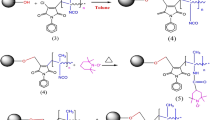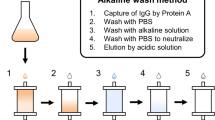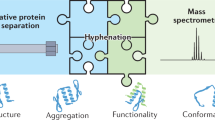Abstract
Reversed-phase high performance liquid chromatography (HPLC) has become the method of choice for the purification of peptides and small proteins (Mr < 10,000 Da) from natural sources. The technique combines high resolution and recovery with ease and speed of operation and is applicable to a wide range of peptides with different physicochemical properties. This protocol describes procedures for (1) the extraction of a biologically active peptide from animal tissue, (2) concentration of the extracts and partial purification on Sep-Pak cartridges, and (3) purification to near homogeneity on a range of silica-based HPLC columns. Standard operating procedures involve acetonitrile as organic modifier, trifluoroacetic acid as ion-pairing reagent and sequential chromatographies on octadecyl (C18), butyl (C4) and diphenyl wide-pore (300 Å) columns under gradient elution conditions. The limiting factor in the time taken to isolate a peptide is usually the speed at which assays to detect the peptide can be performed, but purifications can generally be accomplished within 1 or 2 weeks.
This is a preview of subscription content, access via your institution
Access options
Subscribe to this journal
Receive 12 print issues and online access
$259.00 per year
only $21.58 per issue
Buy this article
- Purchase on Springer Link
- Instant access to full article PDF
Prices may be subject to local taxes which are calculated during checkout



Similar content being viewed by others
References
Jorpes, J.E. & Mutt, V. Contemporary developments in the biochemistry of the gastrointestinal hormones. Recent Prog. Horm. Res. 23, 483–503 (1967).
Guillemin, R., Sakiz, E. & Ward, D.N. Further purification of TSH-releasing factor (TRF) from sheep hypothalamic tissues, with observations on the amino acid composition. Proc. Soc. Exp. Biol. Med. 118, 1132–1137 (1965).
Schally, A.V., Bowers, C.Y., Redding, T.W. & Barrett, J.F. Isolation of thyrotropin releasing factor (TRF) from porcine hypothalamus. Biochem. Biophys. Res. Commun. 25, 165–169 (1966).
Ebersole, T.J., Conlon, J.M., Goetz, F.W. & Boyd, S.K. Characterization and distribution of neuropeptide Y in the brain of a caecilian amphibian. Peptides 22, 325–334 (2001).
Gritti, F. & Guiochon, G. Surface heterogeneity of six commercial brands of end-capped C18-bonded silica RPLC separations. Anal. Chem. 75, 5726–5738 (2003).
Krokhin, O.V. et al. Use of peptide retention time prediction for protein identification by off-line reversed-phase HPLC-MALDI MS/MS. Anal. Chem. 78, 6265–6269 (2006).
Pearson, J.D. & McCroskey, M.C. Perfluorinated acid alternatives to trifluoroacetic acid for reversed-phase high-performance liquid chromatography. J. Chromatogr. A 746, 277–281 (1996).
Fexby, S. & Bulow, L. Hydrophobic peptide tags as tools in bioseparation. Trends Biotechnol. 22, 511–516 (2004).
Mant, C.T., Litowski, J.R. & Hodges, R.S. Hydrophilic interaction/cation-exchange chromatography for separation of amphipathic alpha-helical peptides. J. Chromatogr. A 816, 65–78 (1998).
Legido-Quigley, C., Marlin, N. & Smith, N.W. Comparison of styrene–divinylbenzene-based monoliths and Vydac nano-liquid chromatography columns for protein analysis. J. Chromatogr. A 1030, 195–200 (2004).
Haas, R. & Rosenberry, T.L. Protein denaturation by addition and removal of acetonitrile: Application to tryptic digestion of acetylcholinesterase. Anal. Biochem. 224, 425–427 (1995).
Conlon, J.M. Measurement of neuerokinin B by radioimmunoassay. In Methods in Neurosciences. Vol. 6 (ed. Conn, P.M.) 221–231 (Academic Press, San Diego, California, 1991).
Goraya, J. et al. Peptides with antimicrobial activity from four different families isolated from the skins of the North American frogs, Rana luteiventris, Rana berlandieri and Rana pipiens . Eur. J. Biochem. 267, 894–900 (2000).
Marley, P.D. & Rehfeld, J.F. Extraction techniques for gastrins and cholecystokinins in the rat central nervous system. J. Neurochem. 42, 1515–1522 (1984).
Henry, J.S., Lance, V.A. & Conlon, J.M. Purification and characterization of insulin from Przewalski's horse, zebra, rhino and tapir (Perissodactyla). Gen. Comp. Endocrinol. 89, 299–308 (1993).
Skribanek, Z., Mezo, G., Mak, H. & Hudecz, F. Mass spectrometric and chemical stability of the Asp–Pro bond in herpes simplex virus epitope peptides compared with X–Pro bonds of related sequences. J. Pept. Sci. 8, 398–406 (2002).
Wang, Y. et al. Structural characterization and effects on corticosteroid secretion of endothelin-1 and endothelin-3 from the frog, Rana ridibunda . J. Mol. Endocrinol. 24, 285–293 (2000).
Author information
Authors and Affiliations
Corresponding author
Ethics declarations
Competing interests
The author declares no competing financial interests.
Rights and permissions
About this article
Cite this article
Conlon, J. Purification of naturally occurring peptides by reversed-phase HPLC. Nat Protoc 2, 191–197 (2007). https://doi.org/10.1038/nprot.2006.437
Published:
Issue Date:
DOI: https://doi.org/10.1038/nprot.2006.437
Comments
By submitting a comment you agree to abide by our Terms and Community Guidelines. If you find something abusive or that does not comply with our terms or guidelines please flag it as inappropriate.



